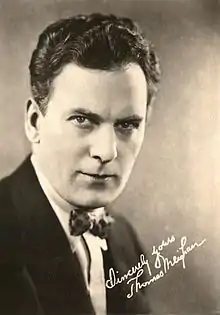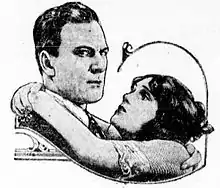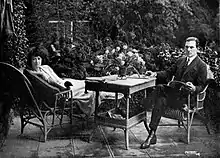Thomas Meighan
Thomas Meighan (April 9, 1879 – July 8, 1936) was an American actor of silent films and early talkies. He played several leading-man roles opposite popular actresses of the day, including Mary Pickford and Gloria Swanson.[1] At one point he commanded $10,000 a week.[2]
Thomas Meighan | |
|---|---|
 | |
| President of The Lambs | |
| In office 1924–1926 | |
| Preceded by | Albert Oldfield Brown |
| Succeeded by | Thomas Alfred Wise |
| Personal details | |
| Born | April 9, 1879 Pittsburgh, Pennsylvania |
| Died | July 8, 1936 (aged 57) Great Neck, New York |
| Spouse(s) | Frances Ring (1909–1936) |
| Occupation | Actor |
Early life
Meighan was born to John and Mary Meighan in Pittsburgh, Pennsylvania. His father was the president of Pittsburgh Facing Mills, and his family was well-off.[2]
Meighan's parents encouraged him to go to college but he refused. At the age of 15 his father sent him to work shoveling coal, which quickly changed his mind. He attended Mount St. Mary's College to study pharmacology.[3] After three years of study, Meighan decided he wished to pursue acting.[2]
Early theatre career
After dropping out of college in 1896, Meighan became a juvenile player in the Pittsburgh Stock Company headed by Henrietta Crosman. He was paid $35 a week.[2]
Meighan soon found success. He first appeared on Broadway in 1900, and four years later appeared in The Two Orphans.[2] His breakthrough role came in 1908 when he appeared with William Collier Sr. in The Dictator; this was followed by a leading role in The College Widow, which had a successful run on Broadway in the 1907–1908 season. During that run he met his wife Frances Ring.[4]
Despite his film career, Meighan remained devoted to the theatre during his life.[2]
Film career
In 1914, he entered motion pictures, at that time still in their infancy. His first film, shot in London, was titled Dandy Donovan, the Gentleman Cracksman. This led to a contract with Famous Players-Lasky.[1] His first US film, in 1915, was The Fighting Hope. During the next two years, Meighan's career took off.[2] In 1918 he made a propaganda film for World War I, titled Norma Talmadge and Thomas Meighan in a Liberty Loan Appeal. He then played opposite Mary Pickford in M'Liss.[1]
Stardom

Meighan hit stardom in 1919. One of his best-known films of the period was that year's The Miracle Man which featured Lon Chaney Sr.;[2] it is now believed to be lost except for brief clips. This was followed with Cecil B. DeMille's Male and Female which starred him opposite Gloria Swanson and Lila Lee. Most of that film's cast returned for the 1920 film Why Change Your Wife? which also co-starred Bebe Daniels.[2] In April 1925, Meighan and Swanson produced a short film directed by Allan Dwan for the annual "Spring Gambol" for The Lambs. This film (sometimes known as Gloria Swanson Dialogue), made in Lee DeForest's sound-on-film Phonofilm process, was made as a joke for the live event, showing Swanson trying to crash the all-male club.
His popularity continued through the Roaring Twenties, during which he starred in several pictures. In 1924 he played in The Alaskan opposite Estelle Taylor and Anna May Wong. In 1927, Meighan starred in The City Gone Wild opposite Louise Brooks.
His final silents, both produced by Howard Hughes in 1928, were The Mating Call, which was critical of the Ku Klux Klan, and The Racket, which was nominated for an Academy Award for Best Picture. Both were thought lost until rediscovered in private collections in 2006; they were restored by University of Nevada, Las Vegas, and shown on Turner Classic Movies.
Talkies and career's end
Meighan's first talkie feature film was The Argyle Case (1928). At this time he was nearing 50; fearing his popularity might wane, he decided to go into real estate. It wouldn't be until 1931 that he would return to the screen with Young Sinners. He would go on to make only four additional talkies until illness sidelined him from acting.[2] His last film was Peck's Bad Boy in 1934.
Personal life
Meighan commanded a salary of $5,000 a week for much of his career. At one point it reached $10,000 a week.[1][2]
Marriage

Meighan met Frances Ring (July 4, 1882 – January 15, 1951)[5] when she was a stage actress on Broadway and he was also appearing there. She was a younger sister of popular singer Blanche Ring and also of vaudeville actress Julie Ring. Actor and director A. Edward Sutherland was a nephew of both Blanche Ring and Meighan. Sutherland's mother, Julie, was a sister of Blanche and Frances Ring.[6]
Meighan and Ring became inseparable and soon married. They remained married until his death in 1936. Their marriage was considered happy and strong; one writer remarked, "Thomas Meighan and Rin Tin Tin were the only Hollywood stars who had never seen a divorce court". The couple had no children.[2]
Hollywood scandals
Meighan was involved in some of the more scandalous moments of silent film history, albeit as a helping hand. He was the sole witness to Jack Pickford and Olive Thomas's secretive wedding in New Jersey on October 25, 1916.[7]
In March 1923, Douglas Gerrad, in need of help bailing his friend Rudolph Valentino out of jail for bigamy, called up a fellow Irishman named Dan O'Brien who happened to be with Meighan at the time. Meighan barely knew Valentino but put up a large chunk of the bail money, and with the help of June Mathis and George Melford, Valentino was eventually freed.[8]
Florida
In the mid-1920s, Meighan became obsessed with Florida after talks with his realtor brother James E. Meighan. He bought property in Ocala, Florida, in 1925. In 1927, he built a home in New Port Richey, Florida, where he was to spend his winters. He intended to shoot his film We're All Gamblers there; however, filming was moved to Miami.
The Meighans hoped to draw other celebrities to the area.[9] On July 1, 1926, The Meighan Theatre opened with a screening of Meighan's movie The New Klondike. Meighan himself was not present but sent a congratulatory telegram.[9]
In 1930, sound was added to the theatre. Meighan himself appeared this time, pushing the button to start the sound. The theatre closed in 1934, a victim of the Depression. It reopened in 1938 under the name 'The New Port Richey Theatre'.[9] The theatre is still open as a community playhouse, under the name Richey Suncoast Theatre.[10]
Death
In 1934, Meighan was diagnosed with cancer. The following year he underwent surgery at Doctors Hospital in Manhattan. He finally succumbed to cancer at 9:10pm on July 8, 1936, passing away at his home in Great Neck, New York. Many of his family were present.
Meighan was originally buried at Calvary Cemetery in Queens.[11] After resting there for almost a year, his remains were moved to a family plot at Saint Mary Cemetery in Meighan's hometown of Pittsburgh.[12]
Legacy
Meighan was a large donor to various Catholic charities and the Federation for the Support of Jewish Philanthropic Societies. Many of his later films survive and have been released on DVD.
Selected filmography
- Danny Donovan, the Gentleman Cracksman (1914, Short) - Dandy Donovan, the Gentleman Cracksman
- Kindling (1915) - 'Honest' Heine Schultz
- The Fighting Hope (1915) - Burton Temple
- Out of the Darkness (1915) - Harvey Brooks
- Blackbirds (1915) - Jack Doggins / Hon. Nevil Trask
- The Secret Sin (1915) - Jack Herron
- Armstrong's Wife (1915) - David Armstrong
- The Immigrant (1915) - David Harding
- Temptation (1915)
- Pudd'nhead Wilson (1916) - Chambers
- The Trail of the Lonesome Pine (1916) - Jack Hale
- The Sowers (1916) - Prince Paul Alexis
- The Clown (1916) - Dick Ordway
- The Dupe (1916) - Jimmy Regan
- Common Ground (1916) - Judge David Evans
- The Storm (1916) - Robert Fielding
- The Heir to the Hoorah (1916, directed by William C. deMille)[13] - Joe Lacy
- The Slave Market (1917) - John Barton
- Sapho (1917) - Jean Gaussin
- Sleeping Fires (1917) - David Gray
- The Silent Partner (1917) - Edward Royle
- Her Better Self (1917) - Dr. Robert Keith
- The Mysterious Miss Terry (1917) - Gordon True
- Arms and the Girl (1917) - Wilfred Ferrers
- The Land of Promise (1917) - Frank Taylor
- Madame Jealousy (1918) - Valour
- Eve's Daughter (1918) - John Norton
- M'Liss (1918) - Charles Gray
- Missing (1918) - Sir William Farrel
- Heart of the Wilds (1918) - Sergeant Tom Gellatly
- In Pursuit of Polly (1918) - Colby Mason
- Out of a Clear Sky (1918) - Robert Lawrence
- The Forbidden City (1918) - John Worden
- The Heart of Wetona (1919) - John Hardin
- The Probation Wife (1919) - Harrison Wade
- The Miracle Man (1919) - Tom Burke
- The Thunderbolt (1919) - Bruce Corbin
- Male and Female (1919) - William Crichton - The Butler
- Peg o' My Heart (1919) - Sir Gerald Adair
- Why Change Your Wife? (1920) - Robert Gordon
- The Prince Chap (1920) - William Peyton
- Civilian Clothes (1920) - Capt. Sam McGinnis
- Conrad in Quest of His Youth (1920) - Conrad Warrener
- Frontier of the Stars (1921) - Buck Leslie
- The Easy Road (1921) - Leonard Fayne
- The City of Silent Men (1921) - Jim Montgomery
- White and Unmarried (1921) - Billy Kane
- The Conquest of Canaan (1921) - Joe Louden
- Cappy Ricks (1921) - Matt Peasley
- A Prince There Was (1921) - Charles Edward Martin
- The Bachelor Daddy (1922) - Richard Chester
- Our Leading Citizen (1922) - Daniel Bentley, lawyer
- If You Believe It, It's So (1922) - Chick Harris
- Manslaughter (1922) - Daniel J. O'Bannon
- The Man Who Saw Tomorrow (1922) - Burke Hammond
- Back Home and Broke (1922) - Tom Redding
- The Ne'er-Do-Well (1923) - Kirk Anthony
- Homeward Bound (1923) - Jim Bedford
- Hollywood (1923) - Thomas Meighan
- Woman-Proof (1923) - Tom Rockwood
- Pied Piper Malone (1924, print held Gosfilmofond) - Jack Malone
- The Confidence Man (1924) - Dan Corvan
- The Alaskan (1924) - Alan Holt
- Tongues of Flame (1924) - Henry Harrington
- Coming Through (1925) - Tom Blackford
- Old Home Week (1925) - Tom Clark
- The Man Who Found Himself (1925) - Tom Macauley
- Irish Luck (1925) - Tom Donahue / Lord Fitzhugh
- The New Klondike (1926) - Tom Kelly
- Fascinating Youth (1926) - Thomas Meighan
- Tin Gods (1926) - Roger Drake
- The Canadian (1926) - Frank Taylor
- Blind Alleys (1927) - Captain Dan Kirby
- We're All Gamblers (1927) - Lucky Sam McCarver
- The City Gone Wild (1927) - John Phelan
- The Racket (1928) - Captain James McQuigg
- The Mating Call (1928) - Leslie Hatten
- The Argyle Case (1929) - Alexander Kayton
- Young Sinners (1931) - Tom McGuire
- Skyline (1931) - Gordon A. McClellan
- Cheaters at Play (1932) - Michael Lanyard
- Madison Square Garden (1932) - Bill Carley
- Peck's Bad Boy (1934) - Henry Peck (final film role)
References
- © Thomas Meighan, Silent Movie Star – goldensilents.com
- "Thomas Meighan, Movie Actor, Dies". The New York Times. July 9, 1936. Retrieved July 23, 2017.
- Baubie, James A. (February 5, 1931). "From Coal Heaver to Miracle Man". Pittsburgh Press. p. 19. Retrieved December 13, 2020.
- Meighan Genealogy Thomas Meighan
- Who Was Who in the Theatre 1912–1976 original material by John Parker, reprinted here by Gale Research (1976)
- Barry Paris, Louise Brooks (Anchor Books, 1990) p. 147
- Long, Bruce (September 1995). "TAYLOROLOGY; The Life and Death of Olive Thomas". public.asu.edu. Retrieved July 23, 2017.
- Leider, Emily W., Dark Lover: The life and death of Rudolph Valentino, p. 211
- "History of the Meighan/Richey Suncoast Theatre". fivay.org. September 5, 2015. Retrieved July 23, 2017.
- Silent Era : Theaters : USA : Florida : New Port Richey : Thomas Meighan Theatre
- "Meighan Death Takes Star of Silent Screen". Motion Picture Herald. 124 (3): 66. July 18, 1936.
- "Body of Meighan Brought to City". Pittsburgh Press. June 13, 1937. p. 8.
- deMille, William C. (2007). "24: The Excitements of Celluloid: The Camel's Nose". In Peter Wild (ed.). The Grumbling Gods: a Palm Springs Reader. Salt Lake City, UT: University of Utah Press. ISBN 978-0-87480-899-5. OCLC 122974473, 608203796, 608020250 (print and on-line), quoting deMille in Hollywood Saga. New York, NY: E. P. Dutton. 1939. pp. 319. OCLC 1353346. (Rouben Mamoulian Collection (Library of Congress) First edition OCLC 655475937) (Also catalogued at OCLC 494267566, 475574309; and OCLC 591194207 (eBook)); and see The Heir to the Hoorah at the American Film Institute Catalog
External links
| Wikimedia Commons has media related to Thomas Meighan. |